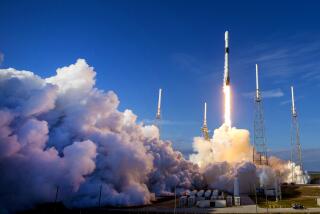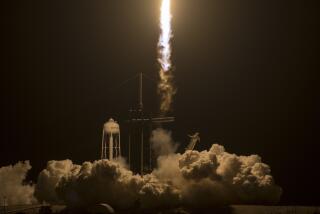Challenger Panel Reconvenes to Weigh Evidence
KENNEDY SPACE CENTER, Fla. — The presidential commission on the Challenger disaster reconvened here Thursday and began to examine a growing mass of debris, photographs, computer readings and other technical data--evidence that together might be enough to pinpoint the source of the space shuttle’s catastrophic explosion.
Six commissioners and a number of staff members were given a private briefing Thursday afternoon, and the full panel was to have a public hearing today--its first since it broke up into teams last week to pursue from a variety of angles the technical mystery of what went wrong with the Jan. 28 flight.
Almost all evidence made public so far has pointed to a ruptured joint in the spacecraft’s right-hand rocket, shown in launch photographs spewing flaming-hot gasses in the seconds before the explosion. Now, it appears, the commission is set to focus on what caused that rupture, and several theories are under intense investigation.
The latest emerged Thursday in the newest edition of Aviation Week and Space Technology, an industry publication considered authoritative on space flight. The magazine said that the commission has seen photographs indicating that ice may have formed in the failed joint before liftoff.
Steam, Smoke in Photos
The pictures reportedly show a white puff of steam at the suspect joint, two-tenths of a second after ignition and before an ominous plume of black smoke was caught by launch-pad cameras. Aviation Week said that it is theorized that the steam in the picture was evaporating ice that had gathered in the lower section of the joint, which has a U shape and, theoretically, could hold small amounts of water.
In the 37 days Challenger sat on launch pad 39B, it was exposed to at least six inches of rain and, on the eve of launching, several hours of sub-freezing cold.
National Aeronautic and Space Administration officials testified later that a trace of rain water was discovered to have collected three years ago in a solid rocket joint. That prompted NASA to begin applying grease to the joints in an effort to prevent future intrusion by rain water.
Another theory about what might have caused the joint to rupture has been advanced by engineers from Morton Thiokol Inc., which builds the booster rockets. They warned on the night before the launching that extreme cold could slow the delicate timing of O-ring booster seals as they became pressurized and positioned themselves to contain rocket propellants. The engineers’ fear was that the propellant could escape through a joint before a perfect seal was formed in the first fractions of a second after ignition.
NASA Doubts Cold Theory
NASA experts, however, have challenged this theory, and this week they began to advance their own. J. E. Kingsbury, chief of science and engineering at the space agency’s propulsion center in Huntsville, Ala., told reporters that the Marshall Spaceflight Center’s “failure scenarios” focus on a ruptured joint, but for reasons other than cold weather.
He said that the joint might have failed because a defect in an O-ring went undetected, or because the assembly of the rocket was not properly conducted.
“If the O-rings sealing the joints had imperfections, it wouldn’t function properly,” Kingsbury said. He added that “the manufacture and assembly process must be thoroughly investigated.”
There have been reports that assembly of the section of rocket believed to have failed took several hours longer than usual, and these have raised questions about assembly procedures. Previous witnesses have told the commission that sections of reusable rockets don’t always fit well when the rockets are reassembled. Sections are interchangeable, and most of those used on the Challenger mission had been flown in different combinations at least twice before.
The best evidence in the riddle of the ruptured joint is believed to be buried off Cape Canaveral beneath waters 1,200 feet deep. Sonar soundings and underwater cameras indicate that this is where the right-hand rocket came to rest, in pieces, after the explosion.
A commission member said in an interview that, while the commission would see some underwater photographs today, the photos would not show the joint in question. Whether the root cause of the rupture can ever be pinpointed might depend on photographs of the section, or its actual recovery from the deep waters.
“It could be several weeks before we are able to know for sure what the exact cause is,” said commissioner David Acheson, a Washington D.C. attorney, estimating how long it will take to retrieve the appropriate sections of the right-hand rocket.
Without recovery of the section in question or at least underwater photographs of it, the commission will be forced to rely on smaller pieces of the puzzle in their final report on what caused the nation’s worst space disaster.
Acheson said the commission today also will review evidence that might allow it “to eliminate some of the systems” from their investigation. For example, there has been no evidence to indicate that the explosion might have resulted from flaws in the shuttle orbiter.
Agenda for Session
The commission statement said that the session today “will focus on the status of salvage operations, studies of possible failure modes of major components, postulation of failure scenarios concerning the Challenger launch, and a review of pre-launch processing of the solid rocket boosters.”
Among the witnesses scheduled to be heard were representatives of Marshall Spaceflight Center who have been involved in tests to determine how cold would effect O-ring performance.
More to Read
Sign up for Essential California
The most important California stories and recommendations in your inbox every morning.
You may occasionally receive promotional content from the Los Angeles Times.











